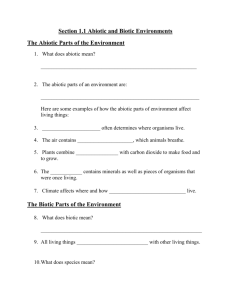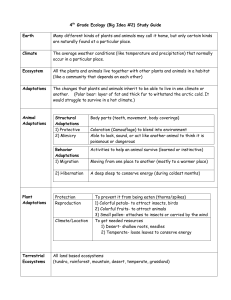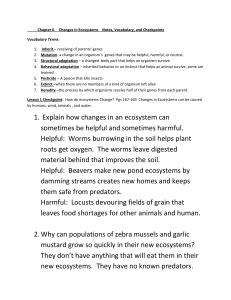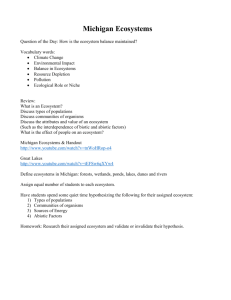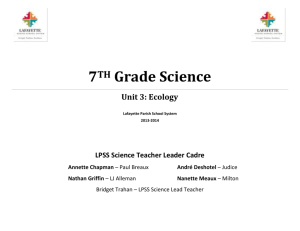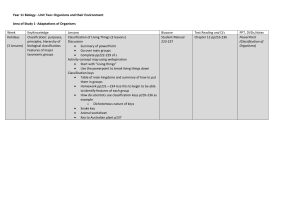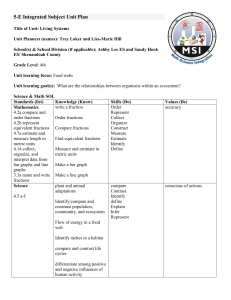7th Grade Science Unit 4: Environmental Science
advertisement
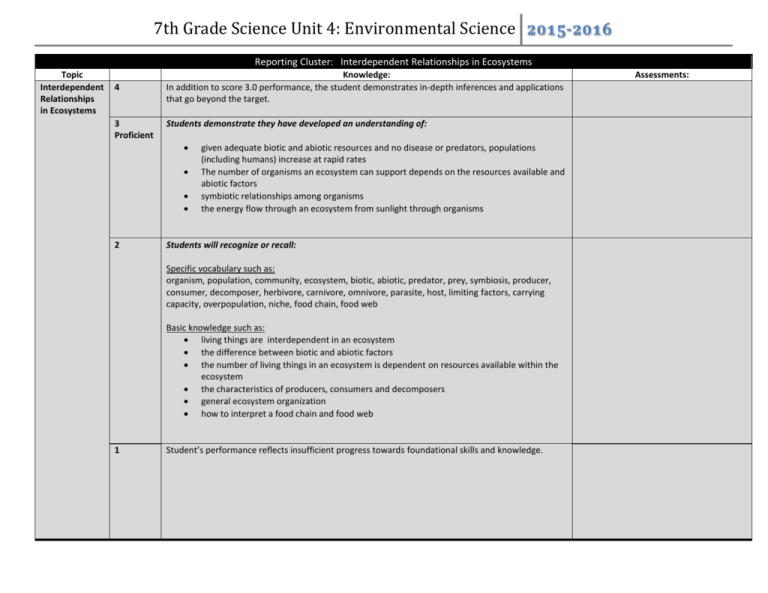
7th Grade Science Unit 4: Environmental Science 2015-2016 Reporting Cluster: Interdependent Relationships in Ecosystems Topic Interdependent Relationships in Ecosystems 4 3 Proficient Knowledge: In addition to score 3.0 performance, the student demonstrates in-depth inferences and applications that go beyond the target. Students demonstrate they have developed an understanding of: 2 given adequate biotic and abiotic resources and no disease or predators, populations (including humans) increase at rapid rates The number of organisms an ecosystem can support depends on the resources available and abiotic factors symbiotic relationships among organisms the energy flow through an ecosystem from sunlight through organisms Students will recognize or recall: Specific vocabulary such as: organism, population, community, ecosystem, biotic, abiotic, predator, prey, symbiosis, producer, consumer, decomposer, herbivore, carnivore, omnivore, parasite, host, limiting factors, carrying capacity, overpopulation, niche, food chain, food web Basic knowledge such as: living things are interdependent in an ecosystem the difference between biotic and abiotic factors the number of living things in an ecosystem is dependent on resources available within the ecosystem the characteristics of producers, consumers and decomposers general ecosystem organization how to interpret a food chain and food web 1 Student’s performance reflects insufficient progress towards foundational skills and knowledge. Assessments: 7th Grade Science Unit 4: Environmental Science 2015-2016 Topic Natural Selection and Adaptations 4 3 Proficient 2 Reporting Cluster: Independent Relationships in Ecosystems Knowledge: In addition to score 3.0 performance, the student demonstrates in-depth inferences and applications that go beyond the target. Students demonstrate they have developed an understanding of: species acquire many of their unique characteristics through biological adaptation which involves the selection of naturally occurring variations in populations Biological adaptations include changes in structures, behaviors, or physiology that enhance survival and reproductive success in a particular environment Students will recognize or recall: Specific vocabulary such as: natural selection, adaptation, evolution, traits, mutation, genes, DNA Basic knowledge such as: some changes in traits are beneficial, while others cause a species to decline evolution is small genetic changes over long periods of time adaptation helps organisms to survive and reproduce in their environment the differences between types of adaptations 1 Student’s performance reflects insufficient progress towards foundational skills and knowledge. Assessments: 7th Grade Science Unit 4: Environmental Science 2015-2016 Reporting Cluster: Interdependent Relationships in Ecosystems Topic Environmental Issues and Human Impacts 4 3 Proficient Knowledge: In addition to score 3.0 performance, the student demonstrates in-depth inferences and applications that go beyond the target. Students demonstrate they have developed an understanding of: 2 the impact of industrialization and human population growth steps individuals can take to lessen their negative impact on the environment scientific evidence surrounding global climate change Students will recognize or recall: Specific vocabulary such as: pollution, conservation, extinction, endangered, deforestation, invasive species, habitat destruction, biodiversity, reduce, reuse, recycle, renewable, non-renewable, biodegradable, conservation, global climate change Basic knowledge such as: human behaviors impact the environment in both negative and positive ways (3 R’s) resources are finite 1 Student’s performance reflects insufficient progress towards foundational skills and knowledge. Assessments: 7th Grade Science Unit 4: Environmental Science 2015-2016 Suggested Instructional Resources Sample Learner Objectives Topic Textbook Resources Labs PBL Ideas (projects) Web Resources – websites or resources on http://science.dmschools.org I can use a food web or food chain to determine relationships among organisms. I can construct explanations for common patterns of interactions within ecosystems. I can use known environmental factors to hypothesize future success of a given population within an ecosystem. Interdependent Relationships in Ecosystems Natural Selection and Adaptations I can construct explanations for how genetic variations of traits in a population increase some individual’s probability of surviving and reproducing. I can explain how human actions affect the environment in both positive and negative ways. I can discuss the impact of industrialization and human impact growth on the environment. Environmental Issues and Human Impacts




